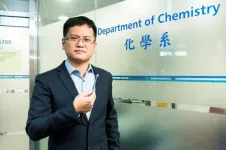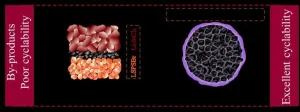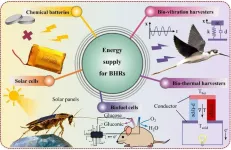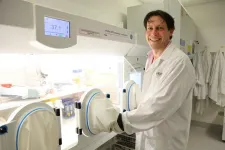(Press-News.org) Often introduced unintentionally by human activities, invasive alien species can outcompete and overwhelm native flora and fauna, driving species to the brink of extinction and disrupting the balance of ecosystems. Understanding why exactly they establish in new locations and how they got there in the first place is crucial if we are to mitigate their destructive effects. Unfortunately, there isn’t enough research on this, and the answers might not always be straightforward.
A research team from AgResearch and Better Border Biosecurity (B3) investigated the biological risk posed by soil on the external surfaces of sea freight such as shipping containers or used machinery at sea ports in New Zealand. With their work, the researchers hope to facilitate the assessment of relative biosecurity risks between different introduction pathways and contribute to the development of more efficient measures against them.
The team found soil on most types of sea freight, irrespective of origin, with all soil likely to vector microbes, including plant pathogens. The amount of soil recovered from a single sea container was 5.3 kg, while the overall mean weight collected from sea freight was 417g, with most of the soil found on the underside of sea freight.
“While the presence of soil is perhaps not surprising, the presence of live bacteria, fungi, worms, seeds and insects associated with the soil was of greater concern. Various regulated biosecurity organisms were recovered from the samples, including plant-parasitic worms, seeds, insects and spiders that were not recorded as being present in New Zealand,” says Mark McNeill of AgResearch, who led the study.
“Not only does the spread of exotic species through these networks represent significant environmental, economic and social costs to natural and agricultural environments if invasive alien species were to establish, a loss of biodiversity is also an expected consequence of invasive alien species establishment. For islands, the implications can be significant, as they have high levels of endemism and invasive alien species establishment can lead to extinction of species as well as biodiversity declines,” the researchers write in their paper, which was published in the open-access journal NeoBiota.
Compared to a previous study on contaminated footwear carried in luggage by international airline passengers, the number and diversity in soil on sea freight was smaller than soil transported in more protected environments (e.g., footwear in luggage). This showed that biosecurity risk can vary with pathway. However, prioritising one soil pathway over another according to the risks they present, and differentially allocating resources is problematic, because the relative risk is dynamic, dictated by factors such as new pests or diseases entering the respective pathways.
Even so, the researchers suggest that contaminated sea freight is an important introduction pathway for exotic species. The establishment of such species can be prevented by cleaning containers prior to departure, inspection at the border, and further cleaning where required.
Original source:
McNeill MR, Phillips CB, Richards NK, Aalders LT, van Koten C, James TK, Young SD, Bell NL, Laugraud A (2023) Defining the biosecurity risk posed by soil found on sea freight. NeoBiota 88: 103-133. https://doi.org/10.3897/neobiota.88.98440
END
A huge step forward in the evolution of perovskite solar cells recorded by researchers at City University of Hong Kong (CityU) will have significant implications for renewable energy development.
The CityU innovation paves the way for commercialising perovskite solar cells, bringing us closer to an energy-efficient future powered by sustainable sources.
“The implications of this research are far-reaching, and its potential applications could revolutionise the solar energy industry,” said Professor Zhu Zonglong of the Department of Chemistry at CityU, who collaborated ...
They published their work on Oct. 18 in Energy Material Advances.
"Constructing a good interface between cathode and electrolyte is crucial for the development of all-solid-state battery," said Chuang Yu, a professor at the State Key Laboratory of Advanced Electromagnetic Technology at Huazhong University of Science and Technology. "Currently, strategies such as coating protect layer on cathode surface and isolating cathode/sulfide electrolyte by halide electrolyte layer are typical solutions to solve the problems at the interface between the cathode and the sulfide electrolytes, but it is not yet clear who is more suitable for sulfide-based all-solid-state ...
Bio-machine hybrid robots (BHRs) represent a new generation of micro-aerial vehicles that be controlled by building an interface between biological and artificial systems. In contrast to conventional bionic robots, they are free of complex mechanical structures, and due to the direct adoption of the animal body, they have superior moving characteristics and lower energy demand. Thus, the BHRs can be applied in many important scenarios, such as urban and wilderness rescue operations, environmental monitoring and hazardous area surveys.
To accomplish long mission endurance, the energy supply ...
Johns Hopkins researchers looking to develop a long-acting, injectable malaria preventive using atovaquone have shown in a new study that resistance may not be the challenge scientists thought it was, particularly when using atovaquone as a malaria preventive. Malaria parasites in infected patients being treated with atovaquone tend to develop a resistance to the drug. Because of this, atovaquone by itself is not used as a malaria treatment nor has not been seen as a strong candidate for use as a preventive.
The study, led by a team of researchers at the Johns Hopkins Malaria Research Institute and the Johns ...
New findings from researchers at UCLA Health suggest that measuring changes in how pupils react to light could help predict recovery from depression and personalize transcranial magnetic stimulation (TMS) treatment of major depressive disorder.
TMS is a safe, non-invasive therapy that uses magnetic fields to stimulate parts of the brain involved in mood regulation. While TMS is proven effective, not all patients respond equally well to the therapy. The ability to predict who will benefit most could allow doctors to better customize ...
Women with diets during middle age designed to lower blood pressure were about 17 percent less likely to report memory loss and other signs of cognitive decline decades later, a new study finds.
Led by researchers from NYU Grossman School of Medicine, the new findings suggest that a mid-life lifestyle modification – adoption of the Dietary Approaches to Stop Hypertension, or DASH diet – may improve cognitive function later in life for women, who make up more than two-thirds of those diagnosed with Alzheimer’s disease, the most prevalent form of dementia.
The findings, published online today in ...
The winners of the Society’s prestigious annual Awards for 2024 have all contributed to improving knowledge and expertise in endocrinology and have helped drive innovation and progression across the field.
Each of these deserving winners will be presenting a plenary lecture at ESE’s annual Congress, the European Congress of Endocrinology (ECE) 2024, which will be held in Stockholm, Sweden from 11-14 May 2024.
The 2024 Geoffrey Harris Award is being presented to Jens C. Brüning (Germany). This Award recognises outstanding researchers in the field of neuroendocrinology. Jens Brüning is the Director of the Max Planck Institute for Metabolism Research ...
The more diverse species in your gut, the better it is for your health. Now an international team led by the Hudson Institute of Medical Research has found a way to determine which species are important and how they interact to create a healthy microbiome.
Understanding these relationships opens the door to a new world of medical opportunities for conditions from Inflammatory Bowel Disease to infections, autoimmune diseases and cancers.
Associate Professor Samuel Forster and his team at Hudson Institute of Medical Research, working with collaborators from the Institute for Systems Biology in ...
Felix Beuschlein is Professor of Internal Medicine/Endocrinology and Director of the Clinic for Endocrinology, Diabetology and Clinical Nutrition at the University Clinic Zurich in Switzerland. He received his medical degree from School of Medicine at the University of Würzburg and completed his medical training in Freiburg, both in Germany. For postdoctoral studies he joined the University of Michigan in Ann Arbor. Following a professorship for Endocrine Research at the University of Munich, he was elected for a chair position at the University of Zurich in 2017.
The Transatlantic ...
A new partnership between Edith Cowan University (ECU), observation data company QL Space, and University of South Wales (UK) is looking to the stars, literally, to create more secure and efficient communication.
The collaboration will focus on ‘free space optics’, which uses light all around we can’t see to communicate, by sending data via light particles, or photons.
ECU School of Science Senior Lecturer Dr Shihao Yan said this brought with it many benefits compared to using radio frequencies to send information.
“When ...




